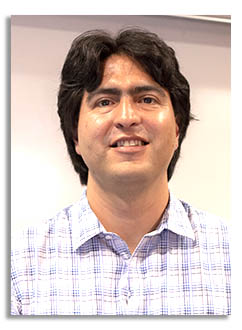
Abstract
Two seminars in separate videos:
This is the first seminar: Click here to see the SECOND SEMINAR
Universidad Técnica Federico Santa María (UTFSM) is a pioneer in Solar Energy research in Chile. The Solar Energy Lab [Renewable Energy Laboratory (LER)] was founded in 1960 and has been a leader in solar development in our country. Initially, the Solar Energy Lab oversaw solar resources Chilean data (up to 2010) and the research had been focused on solar heating system, desalination, and solar ponds. In the last years, the solar research and development at UTFSM has been focused in Solar Thermal Desalination Systems, modelling of Concentrated Solar Power (CSP) systems, and Solar Fuels.
The study of Solar Thermal Desalination Systems has been focused in experimental research and modelling of Humidification Deshumidification (HDH) Systems. In addition, some detailed model of Multi-Effect Desalination system (MED) have been developed. Two experimental units of HDH have been developed: one stage and two stages units. The units are autonomous since the heating power is provided by the solar thermal collector and the motion power of pumps and fans are provided by the solar PV systems. The numerical modelling is focused in developed computational optimization tools able to design an adequate system regarding solar radiation and pure water requirements. The experimental facility is able to test different packed bed, one stage, and two stages in series and parallel. Also, it is possible to adjust mass flow rate of air and water, and different input temperature.
The modelling of CSP systems is looking for a modelling tool to analyse the transient effects due to fluctuation of environmental conditions. Also, a cloud passage induced transients may be analysed, which varies the heat input over a short period of time. A simple cloud shading model based on fractals is implemented to simulate sudden heat input variations. The model system integrates the solar field behaviour, a solar tower, and power block such as Brayton cycles able to work in a dynamic manner.
The solar fuels research is focused in concentrated solar radiation as a clean high-temperature process heat to drive chemical reactions (gasification, pyrolysis, reforming). An inert porous media mixed with biomass, coal or other carbonaceous fuels is used as a novel reactor. If the syngas produced in the process is separated, H2 may be produced. This technology may be an effective alternative to produce H2 using solar energy. Experiments developed in solar gasification of coal demonstrated high temperatures (900-1600 K) and peak H2-yield (8-13%) using different configurations of porous media reactor. Numerical studies of heat and mass transfer, phase changes and chemical kinetics in the process has been developed.
Click here to see all available video seminars.
Click here to go to the SPREE HOMEPAGE.
Brief Bio
B.S. in Mechanical Engineering, UTFSM, Chile (2005). M.S. and Ph.D. in Mechanical Engineering, University of Wisconsin-Madison, United States (2011 & 2015). 2014 to present, Assistant Professor, Department of Mechanical Engineer, Universidad Técnica Federico Santa María, Chile. Director of the LER at the UTFSM and Associate Researcher at the Solar Energy Research Center of Chile. His research interests are thermodynamic and heat transfer of energy systems including cryogenic, refrigeration, and heat processes driven by solar and conventional energy.
